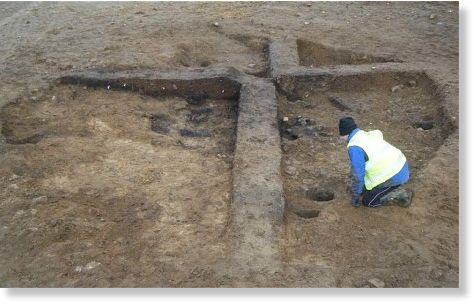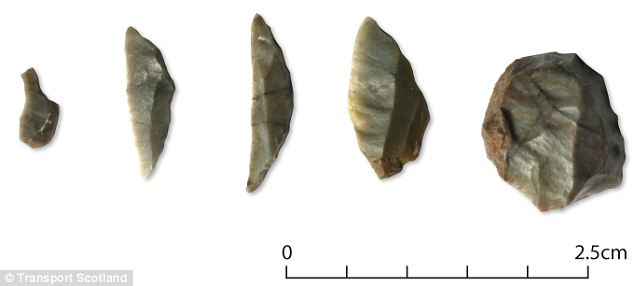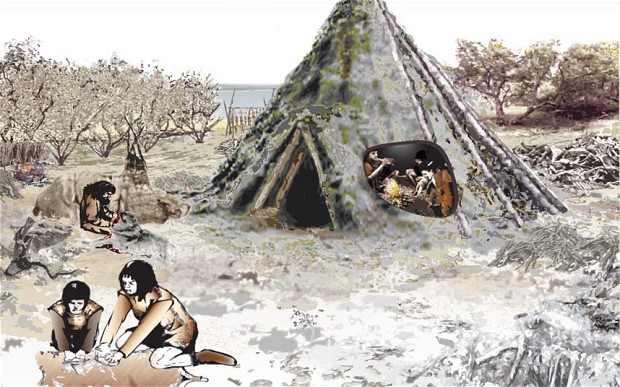It looks like you're using an Ad Blocker.
Please white-list or disable AboveTopSecret.com in your ad-blocking tool.
Thank you.
Some features of ATS will be disabled while you continue to use an ad-blocker.
10
share:
The remains of what is believed to be one of Britain's earliest homes have been uncovered during construction works.
Found this surfing ye ole web and thought it would be interesting to share.
I will try to update as more information is uncovered. Pun intended.
Forth Replacement Crossing

Dig site. You can see the post holes.

Stone tool fragments were found at the site

Who lived in the house?
An artists impression of how the Mesolithic dwelling may have looked.

www.telegraph.co.uk...
Found this surfing ye ole web and thought it would be interesting to share.
I will try to update as more information is uncovered. Pun intended.
The ancient dwelling was uncovered during an archaeological excavation in a field on the outskirts of Edinburgh.
A large oval pit nearly seven metres in length and studded with postholes is all that remains of the dwelling that has been dated to the Mesolithic period, around 10,252 years ago.
A survey of the site was being conducted in preparation for the building of the Forth Replacement Crossing in a field in Echline, South Queensferry, just north of Edinburgh.
Forth Replacement Crossing

Rod McCullagh, a senior archaeologist at Historic Scotland, said: "This discovery and, especially, the information from the laboratory analyses adds valuable information to our understanding of a small but growing list of buildings erected by Scotland's first settlers after the last glaciation, 10,000 year ago.
"The radiocarbon dates that have been taken from this site show it to be the oldest of its type found in Scotland which adds to its significance."
Dig site. You can see the post holes.

The postholes are thought to have once held wooden posts that supported the walls and roof of the building. The roof itself was probably covered with turf, archaeologists believe. The remains of several fireplace hearths were also found inside the building and more than 1,000 pieces of flint, including arrowheads and other tools, were also found.
Other discoveries included large quantities of charred hazelnut shells, suggesting they were an important source of food for the occupants of the house.
Archaeologists believe the dwelling would have been occupied on a seasonal basis, probably during the winter months, rather than all year round.
Ed Bailey, project manager for Headland Archaeology, the company that carried out the excavation works, said: "The discovery of this previously unknown and rare type of site has provided us with a unique opportunity to further develop our understanding of how early prehistoric people lived along the Forth.
"Specialist analysis of archaeological and palaeoenvironmental evidence recovered in the field is ongoing. This will allow us to put the pieces together and build a detailed picture of Mesolithic lifestyle."
Transport Minister Keith Brown said: "This ancient dwelling, which was unearthed as part of the routine investigations undertaken prior to construction works, is an important and exciting discovery.
"We now have vital records of the findings which we will be able to share to help inform our understanding of a period in Scotland's ancient history."
Stone tool fragments were found at the site

Who lived in the house?
The Mesolithic people were hunter gatherers, anatomically indistinguishable from modern humans, who would have subsisted on a diet of wild foodstuffs.
They were among the first settlers in Scotland after the last glacial period (a time within an ice age marked by colder temperatures).
Archaeologists have evidence from the Forth bridge site that they may have eaten birds, fish, wild boar and possibly red or roe deer.
As well as for their meat animals would also been hunted for their hides, sinew, bones, fat and other by-products.
It is not possible to say if the house was a community hub but there was definitely no cattle or other domesticated animal present.
Animal domestication does not begin until the Neolithic, over 4,000 years after the date of the Mesolithic House.
An artists impression of how the Mesolithic dwelling may have looked.

www.telegraph.co.uk...
edit on 11/21/2012 by mcx1942 because: (no reason given)
edit on 11/21/2012 by mcx1942 because: (no reason
given)
edit on 11/21/2012 by mcx1942 because: Tite change
edit on 11/21/2012 by mcx1942 because: (no reason
given)
edit on 11/21/2012 by mcx1942 because: (no reason given)
edit on 11/22/2012 by mcx1942 because: (no reason
given)
Awesome! Thanks for posting I hope to see more information come out about this site as well as other prehistoric European ruins. Perhaps this site
has some correlation with Doggerland.
reply to post by mcx1942
Very cool find Pretty old too. The hearths and some flint were found also. Very hard to imagine what it looked like in that area back then totally different world.
Very cool find Pretty old too. The hearths and some flint were found also. Very hard to imagine what it looked like in that area back then totally different world.
Indeed. My pleasure to share it. There is not of alot of info out about this because it happened a few days ago. It will be very interesting to see if
they find more dwellings.
edit on 11/21/2012 by mcx1942 because: (no reason given)
reply to post by mcx1942
Its a newly discovered dwelling but I see nothing substantial about it... It seems very similar to the Miami Circle, only older.
It does make me wonder though: Is there a natural evolution to tools that correlates to something more than just our surroundings? If we made an exact copy of Earth, would its inhabitants eventually create computers and ask this very same question?
Its a newly discovered dwelling but I see nothing substantial about it... It seems very similar to the Miami Circle, only older.
It does make me wonder though: Is there a natural evolution to tools that correlates to something more than just our surroundings? If we made an exact copy of Earth, would its inhabitants eventually create computers and ask this very same question?
reply to post by Bleeeeep
Indeed, it is not very mysterious but I am really into ancient cultures and I thought I'd share with my friends here.
About making an exact copy of Earth and seeing if the same technologies are produced, is something I have thought about too.
It reminds me of an episode of Stargate Atlantis where Sheppard and McKay find what they think are game consoles deep in Atlantis. But of course, they are actually manipulating real people the Ancients placed on planets to experiment with different outcomes to their evolution of technology and so on.
Indeed, it is not very mysterious but I am really into ancient cultures and I thought I'd share with my friends here.
About making an exact copy of Earth and seeing if the same technologies are produced, is something I have thought about too.
It reminds me of an episode of Stargate Atlantis where Sheppard and McKay find what they think are game consoles deep in Atlantis. But of course, they are actually manipulating real people the Ancients placed on planets to experiment with different outcomes to their evolution of technology and so on.
this is really cool and not even 15 miles from my parents house !
I think its great when they dig up this kind of thing .
So it begins , lets make a simulation of earth and see if it evolves !
I think its great when they dig up this kind of thing .
So it begins , lets make a simulation of earth and see if it evolves !
Excellent find........Just imagine how much more there would be under the coastal waters, particularly between France and England. I would think the
Early Europeans mostly walked, maybe a little rafting, to get from France to England.....During the Ice age. And would have had settlements near the
waters edge, fishing etc. They would all be under the Ocean now, buried deep under the silt of 1000s of years.
I lot of our history is under water now...until the next ice age?
I lot of our history is under water now...until the next ice age?
new topics
-
President BIDEN Vows to Make Americans Pay More Federal Taxes in 2025 - Political Suicide.
2024 Elections: 36 minutes ago -
Ode to Artemis
General Chit Chat: 1 hours ago -
Ditching physical money
History: 4 hours ago -
One Flame Throwing Robot Dog for Christmas Please!
Weaponry: 5 hours ago -
Don't take advantage of people just because it seems easy it will backfire
Rant: 5 hours ago -
VirginOfGrand says hello
Introductions: 6 hours ago -
Should Biden Replace Harris With AOC On the 2024 Democrat Ticket?
2024 Elections: 6 hours ago -
University student disciplined after saying veganism is wrong and gender fluidity is stupid
Education and Media: 9 hours ago -
Geddy Lee in Conversation with Alex Lifeson - My Effin’ Life
People: 10 hours ago -
God lived as a Devil Dog.
Short Stories: 10 hours ago
top topics
-
Hate makes for strange bedfellows
US Political Madness: 15 hours ago, 20 flags -
Who guards the guards
US Political Madness: 17 hours ago, 13 flags -
University student disciplined after saying veganism is wrong and gender fluidity is stupid
Education and Media: 9 hours ago, 12 flags -
Police clash with St George’s Day protesters at central London rally
Social Issues and Civil Unrest: 12 hours ago, 9 flags -
TLDR post about ATS and why I love it and hope we all stay together somewhere
General Chit Chat: 13 hours ago, 7 flags -
Should Biden Replace Harris With AOC On the 2024 Democrat Ticket?
2024 Elections: 6 hours ago, 5 flags -
Don't take advantage of people just because it seems easy it will backfire
Rant: 5 hours ago, 4 flags -
One Flame Throwing Robot Dog for Christmas Please!
Weaponry: 5 hours ago, 4 flags -
President BIDEN Vows to Make Americans Pay More Federal Taxes in 2025 - Political Suicide.
2024 Elections: 36 minutes ago, 4 flags -
God lived as a Devil Dog.
Short Stories: 10 hours ago, 3 flags
active topics
-
President BIDEN Vows to Make Americans Pay More Federal Taxes in 2025 - Political Suicide.
2024 Elections • 1 • : starvosan -
Should Biden Replace Harris With AOC On the 2024 Democrat Ticket?
2024 Elections • 44 • : budzprime69 -
Hundreds of teenagers flood into downtown Chicago, smashing car windows
Other Current Events • 111 • : 777Vader -
British TV Presenter Refuses To Use Guest's Preferred Pronouns
Education and Media • 125 • : Annee -
University student disciplined after saying veganism is wrong and gender fluidity is stupid
Education and Media • 22 • : ImagoDei -
Who guards the guards
US Political Madness • 4 • : kwaka -
New whistleblower Jason Sands speaks on Twitter Spaces last night.
Aliens and UFOs • 44 • : pianopraze -
"We're All Hamas" Heard at Columbia University Protests
Social Issues and Civil Unrest • 263 • : YourFaceAgain -
Remember These Attacks When President Trump 2.0 Retribution-Justice Commences.
2024 Elections • 50 • : Asher47 -
Ode to Artemis
General Chit Chat • 0 • : BrotherKinsMan
10
